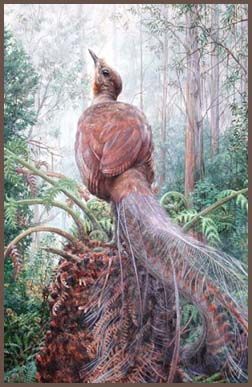(no subject)

Elizabeth Cogley
Lyrebirds are among Australia's best-known native birds, even though they are rarely seen in their natural habitat. As well as their extraordinary mimicking ability, lyrebirds are notable because of the striking beauty of the male bird's huge tail when it is fanned out in display; and also because of their courtship display.
The lyrebird is an ancient Australian animal. The Australian Museum has fossils of lyrebirds dating back to about 15 million years ago.
During the early 1930's, a male lyrebird, called "James", formed a close bond of friendship with a human being, Mrs. Wilkinson, after she had been offering food to him over a period of time. James would perform his courtship dance for her on one of his mounds which he had constructed in her backyard - and he would also put on his display for a wider audience, but only when Mrs. Wilkinson was one of those present. On one such occasion, James' performance lasted for forty-three minutes, and included steps to a courtship dance accompanied by his own tune - and also included imitating perfectly the calls of a Magpie, a young magpie being fed by a parent-bird, a Whip-bird, a Bell-bird, a complete laughing-song of a Kookaburra, two Kookaburras laughing in unison, a Black Cockatoo, a Gang-Gang Cockatoo, an Eastern Rosella, a Pied Butcher-bird, a Wattle-bird, a Grey Shrike-Thrush, a Thornbill, a Scrub-wren, a Striated Pardalote, a Starling, a Yellow Robin, a Golden Whistler, a flock of parrots whistling in flight, the Crimson Rosella, several other birds whose notes his audience were not able to identify, and the song of honey-eaters (tiny birds with tiny voices), that gather in numbers and "cheep" and twitter in a multitudinous sweet whispering. In order to mimic the honeyeaters' singing faithfully, James was obliged to subdue his powerful voice to the faintest pianissimo, but he contrived, nevertheless, to make each individual note of the soft chorus audibly distinct. Also included in James' performance was his perfect mimicry of the sounds made by a rock-crusher at work, a hydraulic ram, and the tooting of motor-horns. -W
lyrebird songs